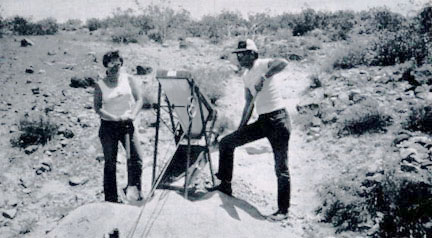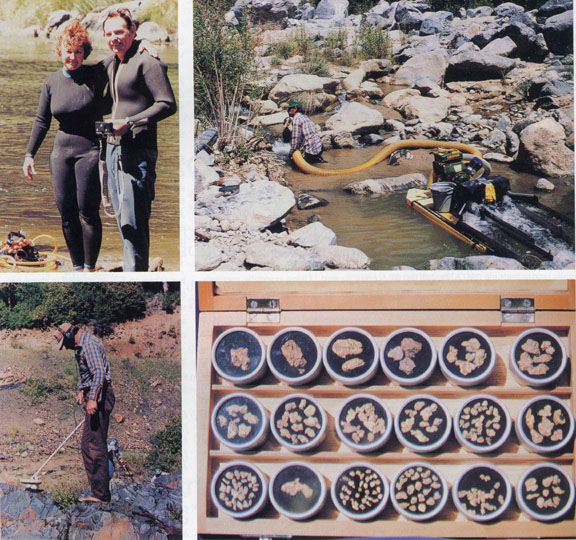BY KITTY NELSON
Whatever can go wrong, will go wrong, and, at the most inappropriate time!
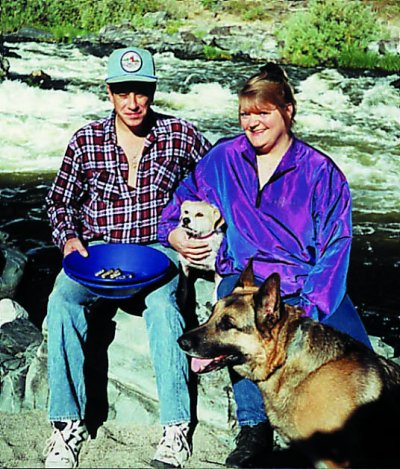 It was spring, and John and I were ready for another adventure on the Klamath River in northern California. We arrived earlier than we normally do, thinking we were really going to get a jump on the season. Well, so much for that idea—the water was raging and visibility was about three inches. We decided we’d do some motorized sluicing while we waited for the water to clear up.
It was spring, and John and I were ready for another adventure on the Klamath River in northern California. We arrived earlier than we normally do, thinking we were really going to get a jump on the season. Well, so much for that idea—the water was raging and visibility was about three inches. We decided we’d do some motorized sluicing while we waited for the water to clear up.
We set up the sluicing equipment on a gravel bar and started shoveling. Within 15 minutes we recovered a one-pennyweight nugget! We took this as a sign—we knew we were going to have a good year!
By the end of June, the water was clear enough to) put the dredge in. The New 49’ers had a new claim downriver, where access was bad — there were no roads in, and it was 250 feet nearly straight down to the water at the lower-end of the claim. But some big nuggets were coming off this claim, and I decided this was the place we wanted to be. All I had to do was to convince John. His philosophy is “If you can’t park at the front door, I don’t want to go.”
It took a few weeks before he reluctantly agreed, so it was the middle of July when we finally went downriver to the new claim. First we set up a tent camp so we wouldn’t
have to drive back and forth to Happy Camp every day. Then John decided the easiest way to get the dredge and all our equipment into the canyon would be to strap it onto an old car hood and slide it down. With the use of both our pickups to help, a snatch block, and our friend, David, we slid the dredge down the mountain with no problem.
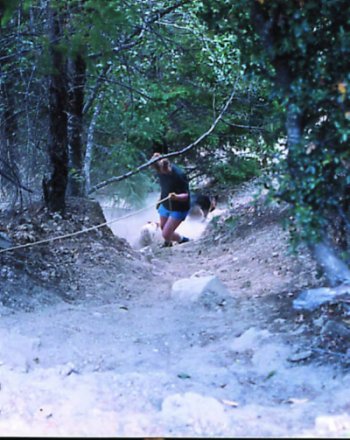 The next day we took our two dogs and climbed down the mountain with the help of a rope tied at the top of the trail.We chose a likely place to start sampling and set up the equipment.
The next day we took our two dogs and climbed down the mountain with the help of a rope tied at the top of the trail.We chose a likely place to start sampling and set up the equipment.
We started finding gold in our first sample hole, but we received a hot tip about the set of rapids two sets above us, and decided to give them a try. You know, gold always glitters brighter on the other side of the river!
We literally dragged our dredge up two sets of rapids. We spent a little more than a week punching sampling holes, only to decide most of it had already been dredged or swept out by high winter flows. So we decided we’d just float back down, sampling along the way.
By the time we made it to the last set of rapids, the water had really dropped. That meant we had to float the dredge through the swiftest part of the rapids. I wasn’t looking forward to this — I was scared!
John tried to convince me it was going to be easy. He said we just had to feed it through the rapids with a rope; and as soon as it was through, it would float over to the side where the water was calm. Sounds easy, right?
We’d no sooner started the voyage when the dredge hung up on a big rock. John waded out and lifted it off, while I held onto the rope. But in the process of lifting it off the rock, he pulled his back and could hardly move. As he bent over the rock in pain, the dredge (free of the rock) started down through the rapids. The rope began burning through my hands. I couldn’t hold it! I curled myself around the pontoon of our supply-float to get better leverage, but then John fell onto the rope as he attempted to help me hold it.
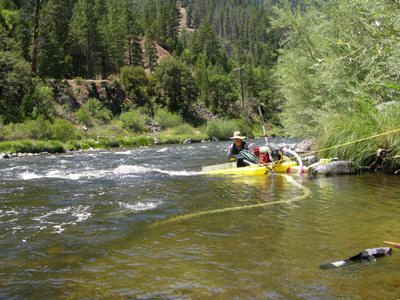 Then, as the rope burned through my fingers again, John (who was still trying to hold onto it) was dragged over the rocks on his stomach. He saw that the dredge was beginning to sink from the strain we were putting on the rope as it fought against the current, and yelled for me to let it go. What a sick, helpless feeling it was to watch our dredge rushing down the river, out of control!
Then, as the rope burned through my fingers again, John (who was still trying to hold onto it) was dragged over the rocks on his stomach. He saw that the dredge was beginning to sink from the strain we were putting on the rope as it fought against the current, and yelled for me to let it go. What a sick, helpless feeling it was to watch our dredge rushing down the river, out of control!
John, who could not even get up by this time, called to me to run downriver and catch it! He thought that the dredge would float out of the current below the rapids, and over to the side of the river.
I was thinking he expected me to run a quarter of a mile down the riverbank, jump into the water (out of breath and wearing combat boots), swim out into the current to the dredge, and pull it into the shore. I was also thinking “Yeah, right! There he goes again, thinking I’m “Lady Schwarzenegger.” But I ran anyway.
I’d almost caught up to the dredge when some rafters happened to float by. They yelled at me to ask if that was my dredge. I told them yes, and they then asked if anyone was holding it. I yelled “No!” and they said “Don’t worry, we’ll get it for you!”
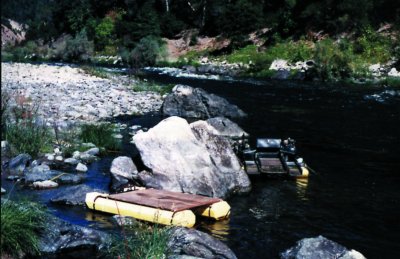 They paddled hard and caught up with it, and pulled it up onto a sand bar on the other side of the river, tying it off on a rock. Thank God for rafters! Without their help, our summer would have been ruined. Our dredge would have surely been smashed up as it went through the next set of rapids, only yards away from where they pulled it out. We decided we’d had enough excitement for the day and went back to our tent camp.
They paddled hard and caught up with it, and pulled it up onto a sand bar on the other side of the river, tying it off on a rock. Thank God for rafters! Without their help, our summer would have been ruined. Our dredge would have surely been smashed up as it went through the next set of rapids, only yards away from where they pulled it out. We decided we’d had enough excitement for the day and went back to our tent camp.
The next morning my back hurt so badly I could hardly stand up. John was in pain, so we broke camp and went back upriver to our fifth-wheel trailer to recoup.
In a few days we felt better, so we took our raft and 3hp motor down into the canyon to pull our dredge back across the river. All went well, and I said to John, “Maybe it’s fate we ended up here. Maybe this is the spot.” So, we decided to punch a sample hole right there.
We discovered one of the dredge engines had water in the gas when we attempted to start it. We called it a day.
The next day we drained the engine and attempted to get it re-started. After several hours it finally started, but we were so tired and full of blisters that we called it a day again.
The next day, I walked the dogs down the riverbank while John took the raft, and I arrived at our dredge site before him — and he was not going to be happy! A bear had been at the site and had torn up John’s new wetsuit! After that, the bear had tried to eat a bottle of dish soap, and must not have cared for it, because nothing else was disturbed.
After John finally quit yelling about his new wetsuit, we called it a day once again and drove to town to buy another wetsuit.
Coming down the trail the next day, John wore my new 60 lb. weight belt, rather than carry it. The trail was a little loose from so much use, so he veered off to the right in hopes of getting better footing. Halfway down, he hit a yellow jacket’s nest. His first reaction was to swat at the swarming wasps—big mistake! He let loose the rope to start swatting, lost his balance, and rolled 70 feet down the hill, still wearing my 60 lb. weight belt! When he finally came to a stop, he managed to get the belt off and started to run for the river, only to trip and fall a few more feet, landing on a rock. He came out of this little adventure with 5 stings, some bad scrapes, and bruised “buns.”
An hour or so later, after he looked like he’d recovered, I asked him if we were going to dredge, or what? He answered “Why, sure! What else could go wrong?”
The “what else” turned out to be one of the foot valves, which wouldn’t prime. We had to tear it apart and rebuild it. By that time most of the day was gone, and we were ready for a day off.
A few days later, we began dredging at our original spot. The day went very well—no breakdowns, no accidents, and cleanup wasn’t bad, either. After 3-1/2 hours of dredging time, we had 6 pennyweights of gold in our sluice box. Things were finally going our way!
John ran the nozzle, and I was his rock person. I’d built a huge rock wall behind us to separate us from a bad undertow in the middle of the river. John had been caught in it earlier, while we were setting up the dredge. I wasn’t going to take any more chances with it, so I put my cobbles to good use. He decided to move a large rock for me, knowing I would have trouble with it. As he shoved the rock out of the way, he smashed his hand between it and another in my rock wall. Several bones in his left hand were broken. So with our tails tucked between our legs, we headed back to camp.
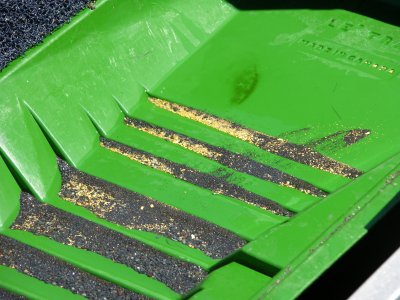 We spent our downtime doing some sightseeing. But after being out of the water for a little more than a month, John was dying to get back to dredging. Every little bump and jar caused him a lot of pain, but he managed to work the nozzle. We finished off the spot we were in, getting good gold right to the finish. That took about a week. But under better circumstances, it might only have taken a day or so. We then moved forward between the next set of boulders. The amount of gold we were finding dropped drastically, and we decided we probably should have dropped further back on the river, instead. The strange currents in this area probably dropped the gold differently from normal.
We spent our downtime doing some sightseeing. But after being out of the water for a little more than a month, John was dying to get back to dredging. Every little bump and jar caused him a lot of pain, but he managed to work the nozzle. We finished off the spot we were in, getting good gold right to the finish. That took about a week. But under better circumstances, it might only have taken a day or so. We then moved forward between the next set of boulders. The amount of gold we were finding dropped drastically, and we decided we probably should have dropped further back on the river, instead. The strange currents in this area probably dropped the gold differently from normal.
It was late in the season by then — the weather was cooler and so was the water. John’s hand still bothered him a lot, so we decided to throw in the towel and head for Arizona.
Even with all the mishaps, this was one of the best summers we’ve ever had. Ask us ten years from now what we did last summer, and we will laugh and recall all of our adventures as though it were yesterday.
We will be back next year. Look for us at the weekly Saturday-night potlucks-we’ll be the couple with all the band aids and bruises!


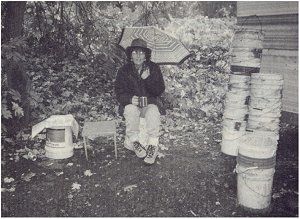 Three months of planning, over a thousand miles of traveling, anticipation of
Three months of planning, over a thousand miles of traveling, anticipation of 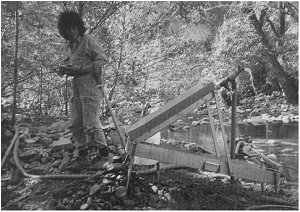 The trip to Columbia was uneventful; but it was a very, very long drive. We finally arrived at the road which would lead us down to the river. As we descended, we saw ahead of us large billowing clouds of smoke coming over the mountain ridge. We could not believe that we had driven all this way and the mountain was on fire! This was
The trip to Columbia was uneventful; but it was a very, very long drive. We finally arrived at the road which would lead us down to the river. As we descended, we saw ahead of us large billowing clouds of smoke coming over the mountain ridge. We could not believe that we had driven all this way and the mountain was on fire! This was 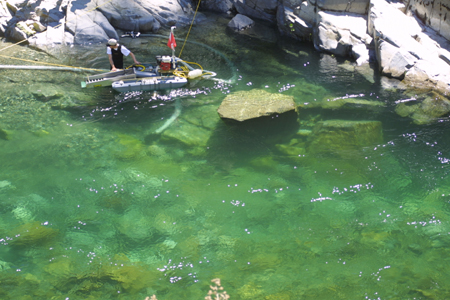 Things were going good and looking better. Yesterday had been a long day, but not as long as I was able to work; about three and a half tanks of gasoline or seven hours. Today, as planned after the gold weigh-up last night, I was at the river early, determined to put in at least a four-tank day . . . and pull my first half-ounce of gold in a day!
Things were going good and looking better. Yesterday had been a long day, but not as long as I was able to work; about three and a half tanks of gasoline or seven hours. Today, as planned after the gold weigh-up last night, I was at the river early, determined to put in at least a four-tank day . . . and pull my first half-ounce of gold in a day!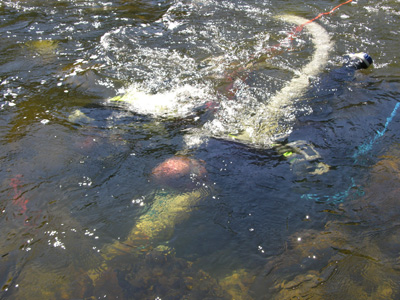
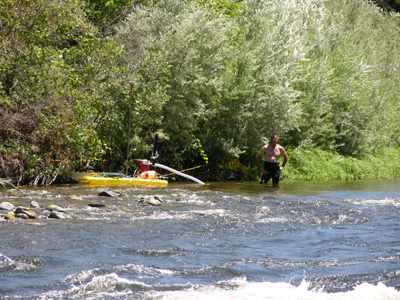
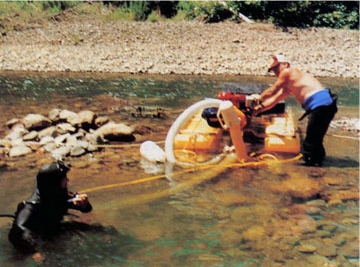 My BH (Big Hubby) and I became interested in
My BH (Big Hubby) and I became interested in 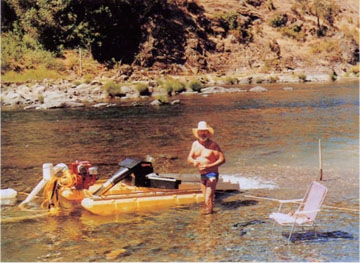
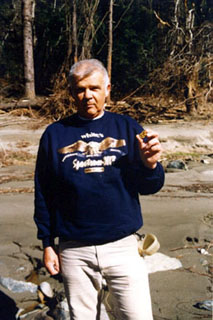 During my recent visit to
During my recent visit to 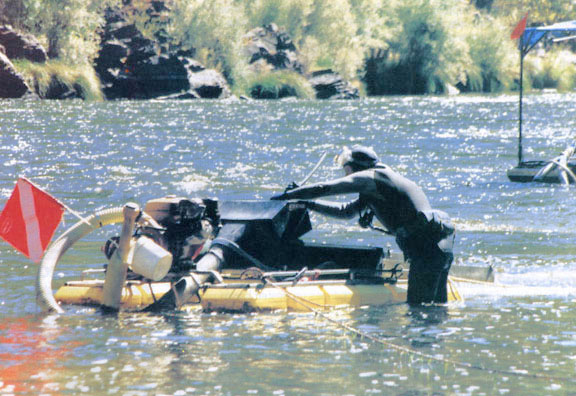
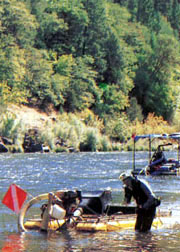 John remained unmarried until he was 40. While on a trip to Mexico, he met a lovely young woman and began courting her in the traditional way, with a “duenna,” or chaperone, along whenever they met. After returning home, they carried on a correspondence, and he finally proposed by mail. After marrying her in Mexico, he brought her home to Vancouver, where he had a home built for them, and they raised two daughters.
John remained unmarried until he was 40. While on a trip to Mexico, he met a lovely young woman and began courting her in the traditional way, with a “duenna,” or chaperone, along whenever they met. After returning home, they carried on a correspondence, and he finally proposed by mail. After marrying her in Mexico, he brought her home to Vancouver, where he had a home built for them, and they raised two daughters.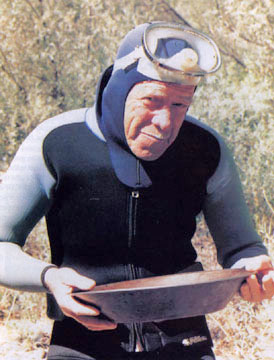 I stress that he dredges alone, because John Coombs has celebrated his 70th birthday, and most people that age who do dredge don’t dredge by themselves. John has won the respect of all his fellow miners along the
I stress that he dredges alone, because John Coombs has celebrated his 70th birthday, and most people that age who do dredge don’t dredge by themselves. John has won the respect of all his fellow miners along the 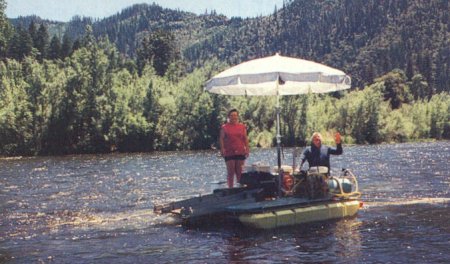
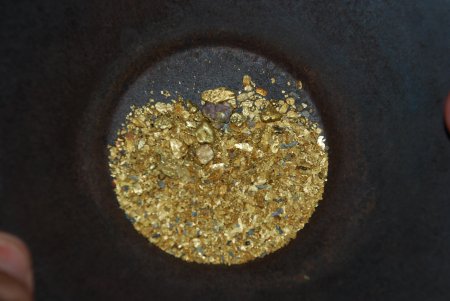 They have concentrated most of their efforts into areas where other people do not want to work—mostly in very fast water, and have done quite well. When they quit dredging, they had accumulated between seven and eight ounces of gold by the end of August, this past season.
They have concentrated most of their efforts into areas where other people do not want to work—mostly in very fast water, and have done quite well. When they quit dredging, they had accumulated between seven and eight ounces of gold by the end of August, this past season.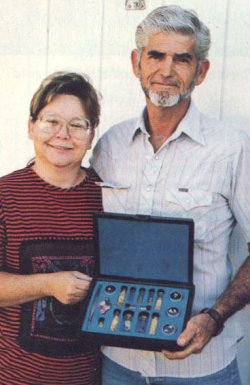
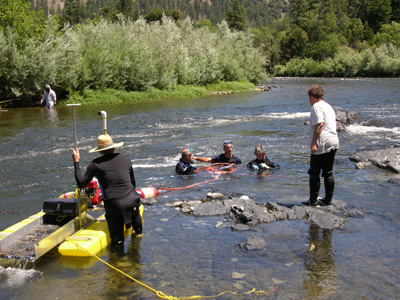 Does your husband have a new hobby? Did he one-day show up with a gold pan, vial, snifter bottle, tweezers and screen?
Does your husband have a new hobby? Did he one-day show up with a gold pan, vial, snifter bottle, tweezers and screen?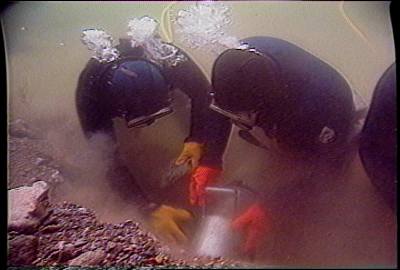 Interestingly enough, you discover your neighbor has this same hobby. You’ve lived next door for a number of years, and you think you would have known. Paul’s excitement rekindled our neighbor’s gold fever and he remembered a bucket of
Interestingly enough, you discover your neighbor has this same hobby. You’ve lived next door for a number of years, and you think you would have known. Paul’s excitement rekindled our neighbor’s gold fever and he remembered a bucket of 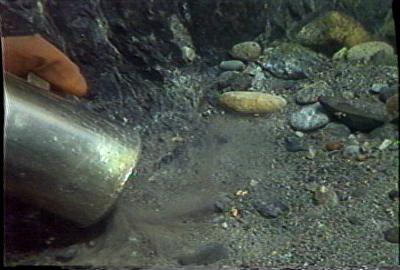 That is how it all started for us. The next thing I knew, my brother-in-law, Kevin, had introduced Paul to a few more
That is how it all started for us. The next thing I knew, my brother-in-law, Kevin, had introduced Paul to a few more 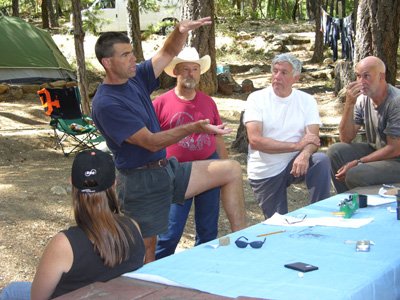 Have you ever been to a
Have you ever been to a 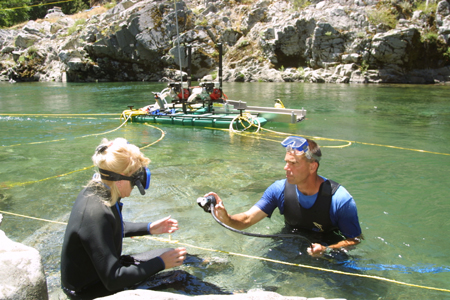 Day two is a demonstration with a visual of a mock river showing how and where gold deposits. Then we caravanned for a tour of different spots on the river where other people had been successful in finding gold. Dave tied together the theory, with the simulation of the actual field conditions.
Day two is a demonstration with a visual of a mock river showing how and where gold deposits. Then we caravanned for a tour of different spots on the river where other people had been successful in finding gold. Dave tied together the theory, with the simulation of the actual field conditions.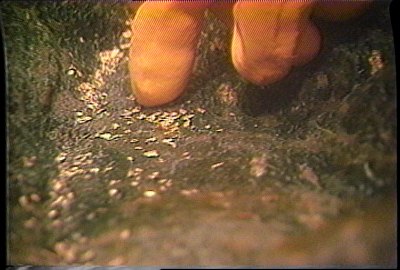 Once you actually see the gold being recovered out of a natural
Once you actually see the gold being recovered out of a natural 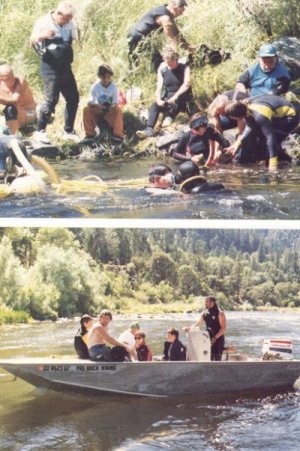 Now I think I’d happily trip over a dredge in our garage that we could take to Happy Camp to put in the Klamath River every summer.
Now I think I’d happily trip over a dredge in our garage that we could take to Happy Camp to put in the Klamath River every summer.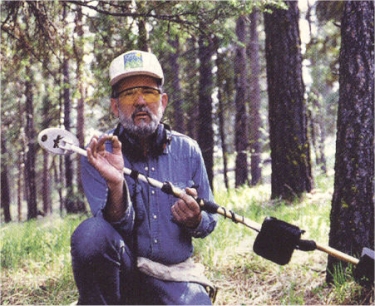 Searching for tiny, elusive
Searching for tiny, elusive 